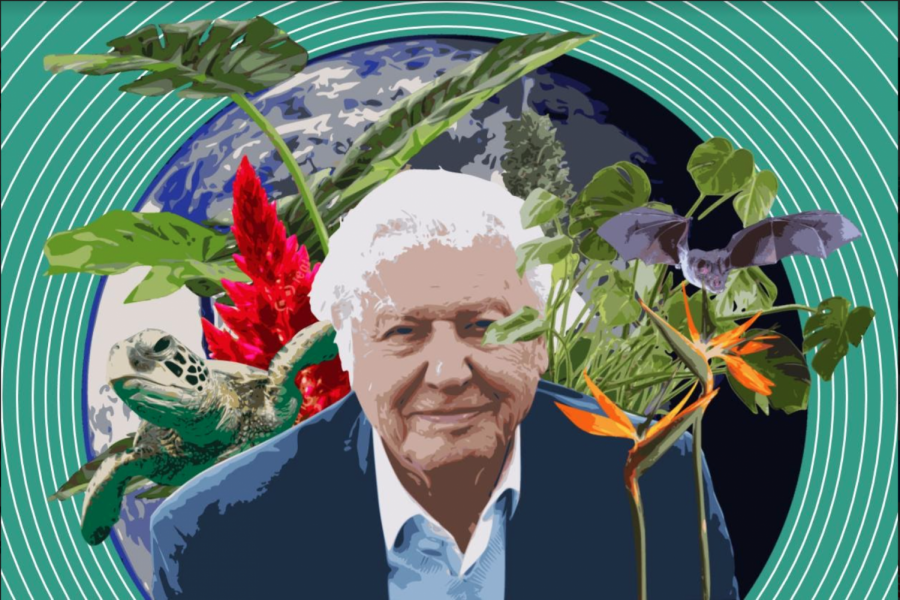A Life on Our Planet: Not Your Average Science Museum Documentary
October 30, 2020
Rating: 5/5 Falcons
The brand new documentary, David Attenborough: A Life on Our Planet, released on Netflix on October 4th, is anything but your average science museum documentary. The film opens with the protagonist and narrator, the world famous naturalist David Attenborough, on the remains of what used to be a home in Chernobyl, a small Ukranian town known worldwide for hosting a nuclear plant meltdown that rendered the town completely uninhabitable, making it one of the worst man-made disasters of the last century.
Once the stage is set, the audience is guided through Attenborough’s 60 year career as a naturalist, and how sharply the world has changed around him in those years. The film is centered around the steep decrease of biodiversity in our planet. It is organized chronologically through the decades, marking the different stages of Attenborough’s career and the continuous losses our planet endured over each ten-year period. Before every new decade, producer Colin Butfield added a black screen with white font reading the global population, the CO2 levels, and the percentage of wildlife remaining. This touch allows the viewer to connect the plunge that our planet has taken with individuals, as well as sets of events that have taken place since the 1930s.
The film is broken down into three major sections. The first comprises of Attenborough highlighting the scale of the problem. The second sees Attenborough warn of additional consequences in the future. Despite these bleak two first segments, the third and final works to install a sense of hope in viewers, with the film ending on a pulled-back shot revealing Chernobyl as a whole, in its vacancy, and the lush wildlife that has grown in place of humans. This small yet powerful touch really puts an emphasis on the ending, and leads the documentary off on a very good note, showing that ruin can become regrowth.
Attenborough began exploring the world in his twenties, filming and photographing the natural wonders of our planet without any commentary on its declining state. At the age of 94, Attenborough has decided to speak on the utter destruction of wildlife due to climate change. Throughout A Life on Our Planet, Attenborough attests to the fact that a great amount of wildlife has been forever lost, indicating a grim future if humanity continues down the road of self-destruction.
To illustrate the emptying of oceans, the directors interchange between cuts of thriving coral habitats with images of large gutted and frozen fish trapped in fishing nets. Equally upsetting is the loss of rainforests, showcased through the stark cutoff between flourishing vegetation and uniform rows of oil palms planted for profit. The most devastating sequence finds Attenborough charting the disasters we face in future decades: global crises that he, as a man now in his 90s, will not experience. I find that the juxtaposition of the scenes discussed above not only display the degree to which we have destroyed our planet, but it also shows how a healthy planet is more beautiful, and a grim, polluted, dark, and dying place is much less coveted, yet we are still walking down that path.
Thankfully, the documentary takes a more optimistic turn approaching the end, as major environmental victories are highlighted, and the film begins to focus not on a scorched, apocalyptic future, but a world restored. Attenborough runs through a few successes: from sustainable farming in the Netherlands and how it has made the country one of the worldwide leaders in food exports, to fishing restrictions around the Pacific archipelago nation of Palau which have enabled marine life to rebound. These few moments of optimism, coupled with some emphatic music, really got me inspired and pumped about making a positive impact.
As I said earlier, this is not your typical documentary, and in my opinion, it is the most powerful and insightful nature documentary I have ever watched. Attenborough is so successful in displaying the problem, but shows that there is still hope and the possibility to get out of the situation we are in if we make major changes. Politically, this documentary could not have been released at a better time. With the recent US presidential debates, it has become quite clear that we cannot depend on our administration to take care of climate change, and that we must rise to the occasion and make a change for the better. Just like a small mistake was able to evacuate a whole town, so can a small improvement have large consequences on the world.











